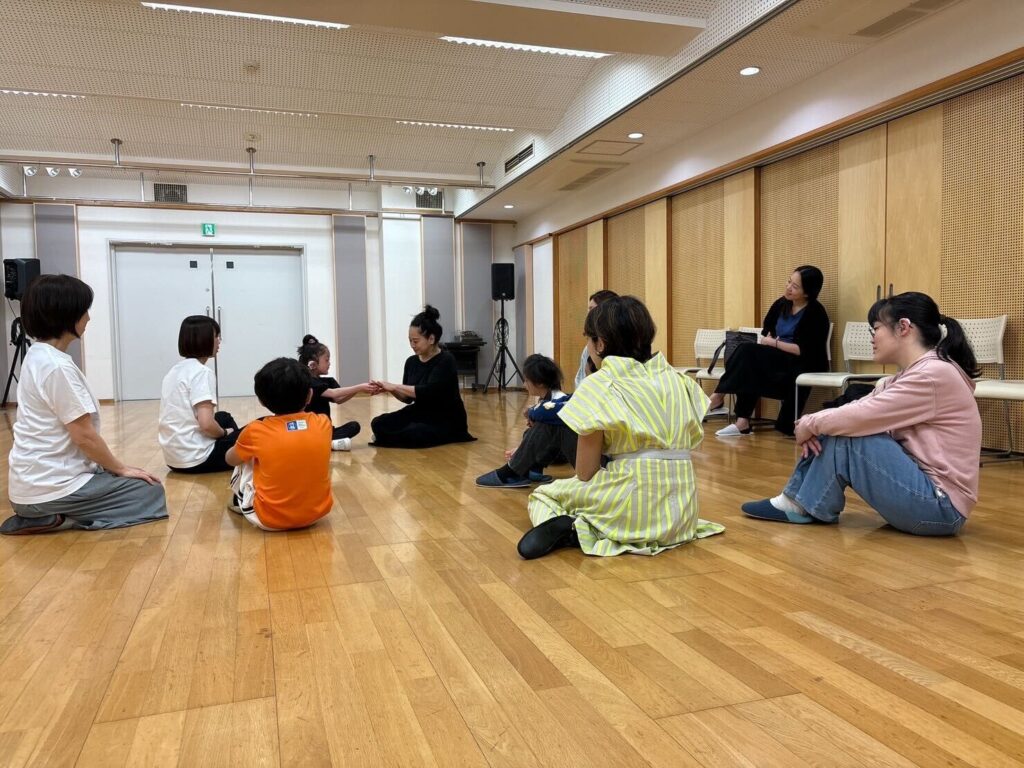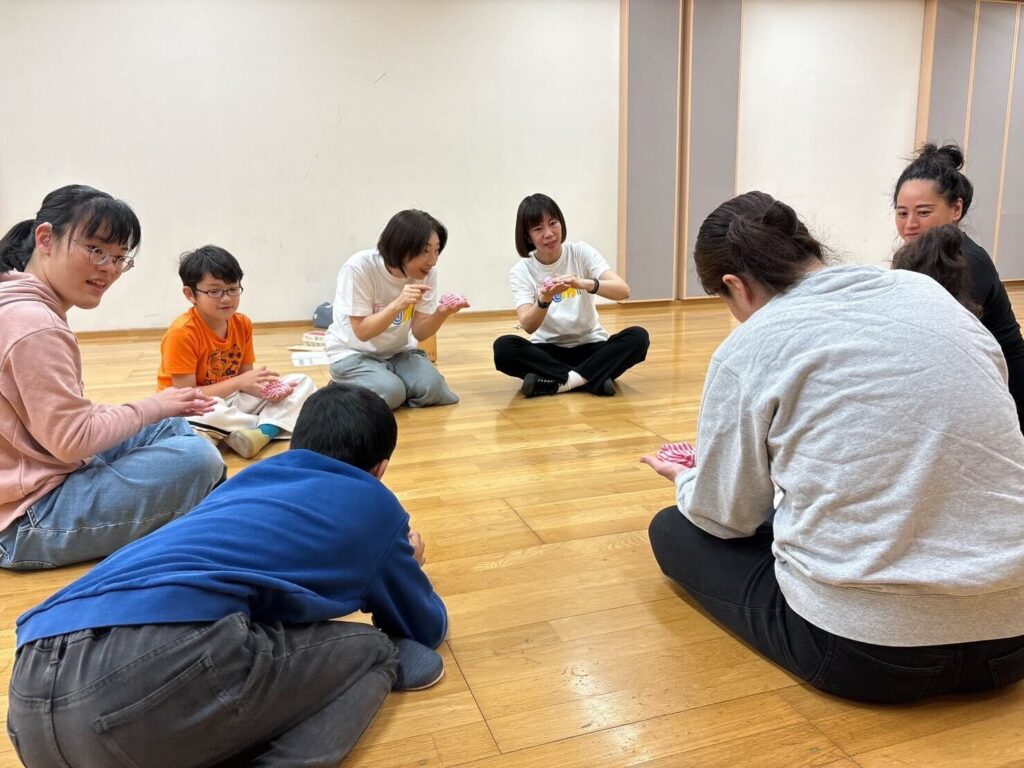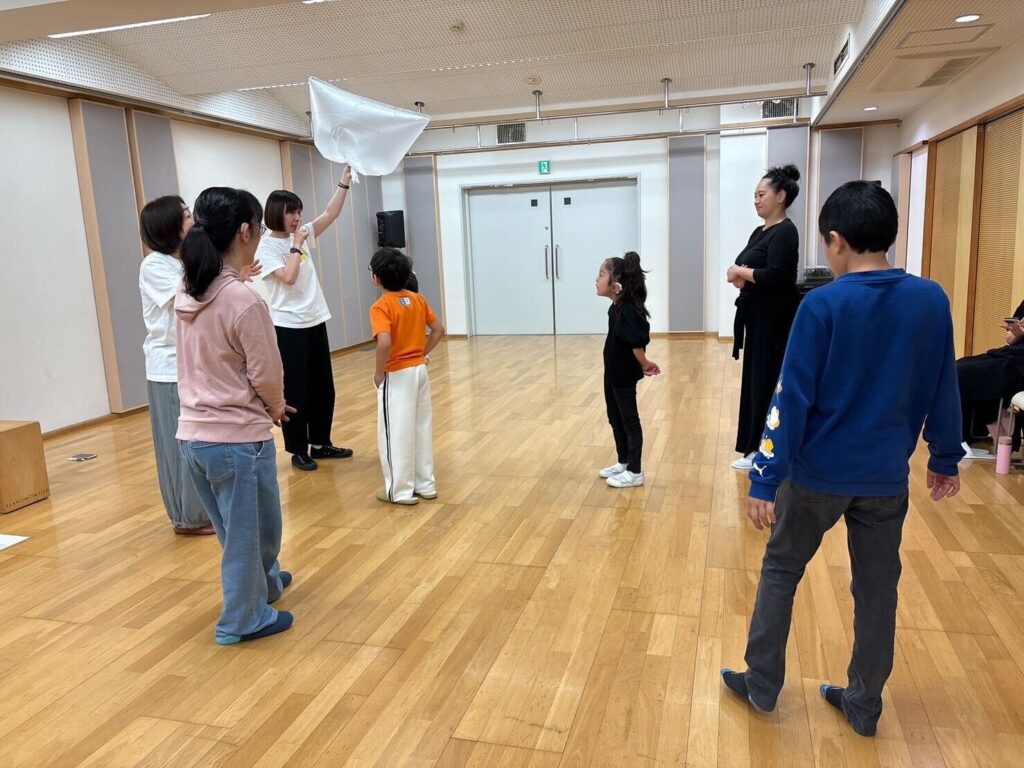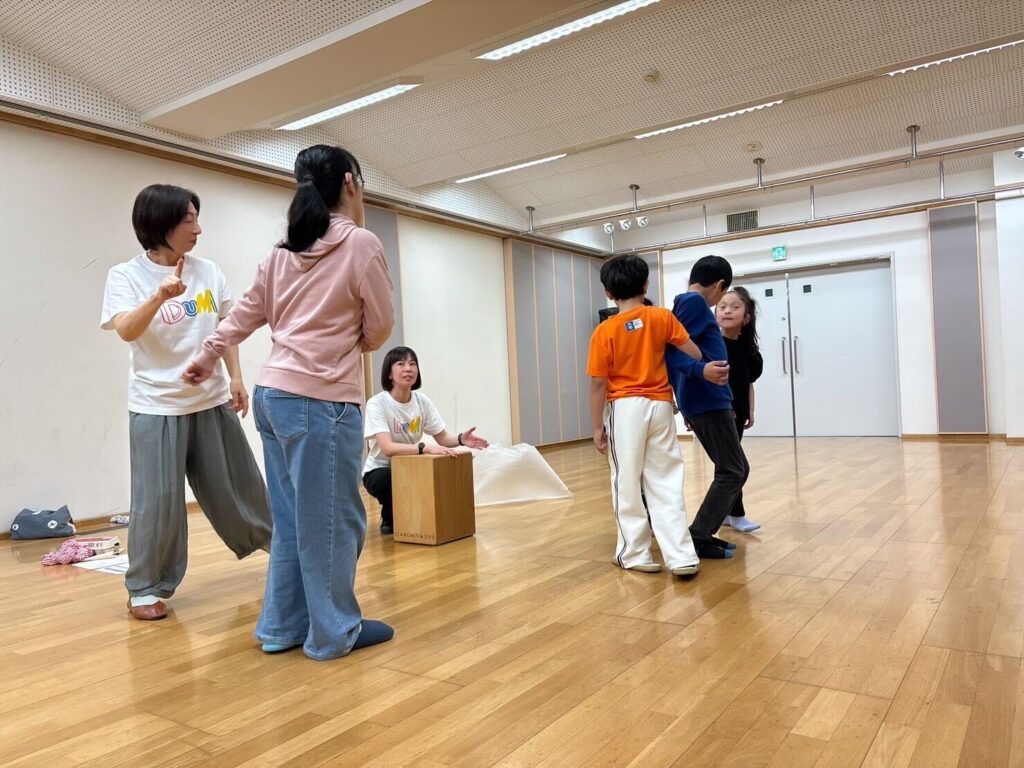
※Classe de la Coquilleは(5歳(年長)〜小学3年生を対象にした)DUMIのクラス名です。
※ろう者も参加するDUMI音楽ワークショップには、手話通訳が必ずサポートに入ります。
テーマ:Silence(静けさ・小さな音)
時間:9:30〜10:15
( 手話通訳:田家先生 アシスタント:戸村めぐみ)
この日の「Classe de la Coquille」では、“静けさ”や“弱い・小さな音”をテーマに、五感を研ぎ澄ましながら音と向き合う時間を過ごしました。
・音の始まりは「集中」から
まずは簡単なウォーミングアップのあと、半円になって座り、自分自身の感覚に意識を向ける時間を持ちました。
2種類の木でできた卵型のオブジェを手に取り、視覚・嗅覚・触覚に集中します。
「色が違う」「重さや手ざわりが違う」といった気づきが子どもたちから自然に生まれ、静かな空間の中で集中力が高まっていく様子が印象的でした。また、子どもたちがたまごオブジェを隣の人に渡す時、非常に丁寧に優しく手渡していた姿が見られました。

・音を感じる「お手玉」の体験
続いて登場したのは、さまざまな素材が詰められた音の出るお手玉(sac à son)。
合図があるまで触らず、自分の順番が来るのを静かに待つことも、集団で過ごす過程において大切な要素の一つです。
振る・こする・落とす・耳元で聴くなど、子どもたちは自由に試しながら音の出し方を探り、「小豆?」「お米?」「貝殻みたい」と想像をふくらませていました。
音を「出す」だけでなく「聴く」ことへの感度が高まる時間となりました。

・音を出さないことに挑戦
次の活動は、風船のようにふくらませた大きなビニール袋を、音を立てずに隣へ渡すというもの。
足音も声もビニールの擦れる音も立てないよう、慎重に、ゆっくりと動く必要があります。
子どもたちは動きを工夫しながら、相手の様子を見て丁寧にビニールを手渡していました。
「静けさを保つ」という意識が自然と育まれていきます。
ゆっくりと音を立てずに慎重に動く子どももいれば、大胆に早足で相手に近づき手渡そうとする子どもいて一人一人動きを考えて表現していました。

・カホンで体感する「リズム」
最後は、カホン(打楽器)に一人ずつ座り、音の振動を体で感じる活動を行いました。
「お尻に振動が伝わってきた」「びっくりした」といった感想があがり、音を“聴く”だけでなく“感じる”経験となりました。
その後はカホンのリズムに合わせて「4歩歩く→4拍休む」を繰り返す動きに挑戦。
音楽の拍を身体で感じながら、歩く・止まるという動作を通してリズムの基本を体感しました。

・まとめ:感覚をひらいて、音と出会う
この日の活動では、「音を出す」ことだけでなく、「音を出さない」「静けさを味わう」ことにも意識を向ける時間が流れました。
子どもたちは五感をフルに使いながら、小さな音の魅力や、静かな空間の心地よさを体験しました。
静寂の中にある豊かな世界に出会う、貴重なひとときとなりました。
“Classe de la Coquille” is the name of DUMI’s class for children aged 5 (kindergarten senior year) to third grade in elementary school. Theme: Silence (Stillness and Subtle Sounds) Time: 9:30–10:15 (Sign Language Interpreter: Ms. Taie / Assistant: Megumi Tomura)
In this session of Classe de la Coquille, children spent time engaging deeply with sound through the theme of “silence” and “soft, subtle sounds,” sharpening their senses and expanding their awareness.
● The Beginning of Sound Is “Concentration”
After a short warm-up, the children sat in a semicircle and took time to quietly focus on their own senses.
They held egg-shaped wooden objects made from two different types of wood, using sight, smell, and touch to explore their differences.
Comments like “The color is different,” “It feels heavier,” or “The texture is smoother” naturally emerged, and their growing focus in the quiet atmosphere left a strong impression.
They also showed care and gentleness when passing the eggs to their neighbors, handing them over with quiet attention and respect.
● Experiencing Sound with “Sound Beanbags”
Next, they explored sac à son—beanbags filled with different materials that make sound.
They waited patiently and silently for their turn, learning the importance of shared time and group dynamics.
Shaking, rubbing, dropping, or listening closely—children freely experimented to discover how each beanbag produced sound.
Their imaginations came alive: “Is it adzuki beans?” “Rice?” “It sounds like seashells!”
It was a time not only for making sound, but also for becoming more sensitive to listening.
● The Challenge of Making No Sound
The next activity involved passing a large, balloon-like plastic bag without making a sound.
They had to move very slowly and carefully, avoiding footfalls, voices, or the rustle of plastic.
Each child paid close attention to others, adjusting their movements to pass the bag gently.
They naturally developed a sense of “maintaining silence.”
Some moved slowly and quietly with great care, while others boldly tried quick steps—each child found their own expressive approach to the challenge.
● Feeling Rhythm with the Cajón
For the final activity, each child sat on a cajón (a box-shaped percussion instrument) and felt the sound vibrations through their body.
They shared reactions like “I felt it in my seat!” and “It surprised me!”—a tactile experience of sound beyond just hearing.
Then, they tried walking four steps in rhythm, followed by four beats of stillness, in sync with the cajón’s beat.
This helped them internalize the basics of rhythm through walking and stopping, using the body to feel music.
● In Conclusion: Opening the Senses to Encounter Sound
This day’s class was not just about “making sound,” but also about “not making sound” and savoring stillness.
The children used all five senses to discover the charm of small sounds and the comfort of quiet spaces.
It was a rare and enriching moment—an encounter with the deep world that exists within silence.


